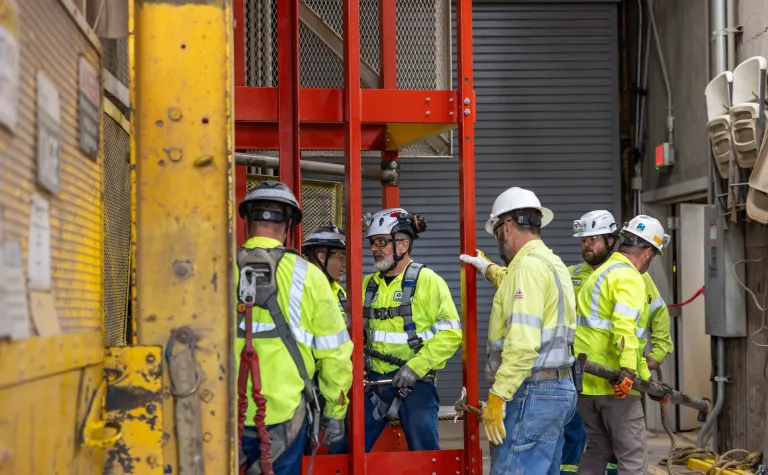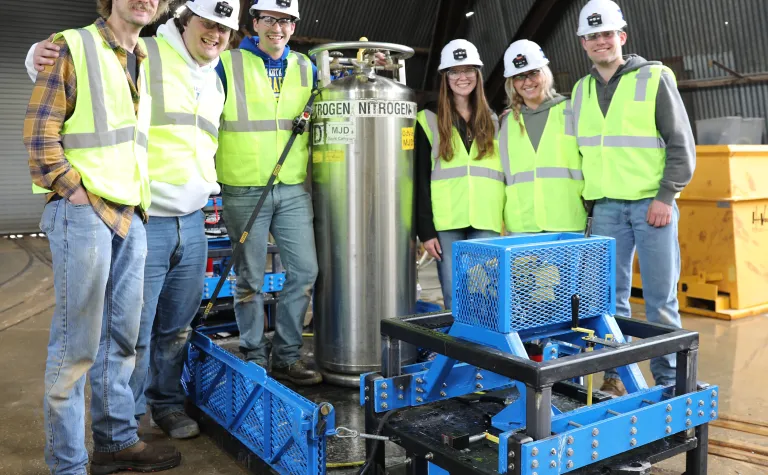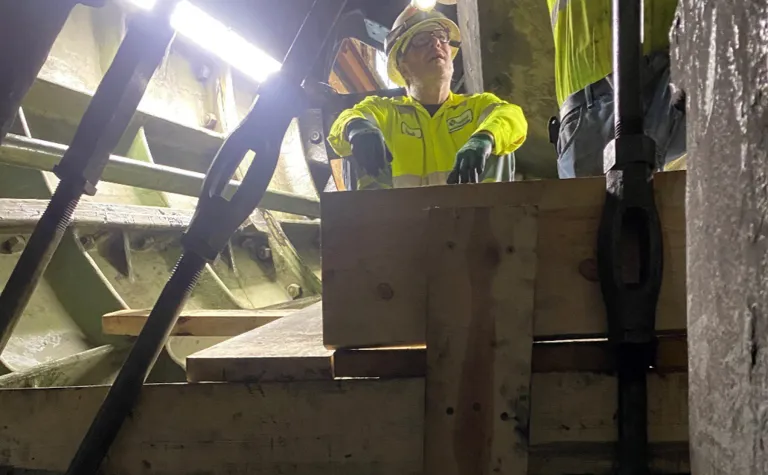Making history in the Yates Shaft
Executing top-down maintenance on a 20th century marvel
Back in 1939, crews in Lead, South Dakota, began sinking a new shaft to facilitate and access the shifting location of underground operations. Designed to last until the ore body was extracted, the tower of timber created a precise frame encasing the Yates Shaft and its operations to deliver people and supplies deep beneath the Black Hills. With separate compartments for transporting people downward and ore and waste rock upward, plus providing air flow, electrical power, compressed air, industrial water, and communications, the shaft served as a lifeline to the surface.
Infrastructure Technician Will Hover discussed his perspective of what the Yates Shaft was like when it was new in one word, “Incredible. We talk about that quite a bit. With the technology back then and how crazy they had to be. That’s really a testament to those guys of how it’s held up. It was really only supposed to last 50 years and it’s going on 80.”
Creating such a structure during the Great Depression proved how fiscally important the project was to Lead, to South Dakota, and to the country. A structure like this also requires continuous maintenance to ensure its integrity.
Fast forward nearly 85 years. The shaft designed to support a half century of mining is still in operation, far beyond its original years. Caring for this wooden tower—a structure more than three-times as tall as the Willis Tower (formerly the Sears Tower) in downtown Chicago—is always ongoing requiring spot fixes and upkeep. That is, until those repairs needed to be an all-day, everyday operation.
The straw that broke the camel's back
“July 5. It was July 5, 2021.” Hoists and Shafts Director Wendy Straub easily recalled the day it became clear that the Yates Shaft needed more than routine maintenance. It needed a lot more.
“We had several outages. We did shut down for a while and then we put together this really awesome plan we called RTO – return to operation.” Straub outlined the initial plan to address what appeared to be the most significant areas requiring attention.
“The second tipping point where we said, ‘It’s indefinite,’ was the discovery of the rock just below the 4100.” Nearly four-fifths of the way down, a boulder was visible behind the lacing used to wrap the rock layers and keep pieces of the earth from entering the shaft. Straub and her team made a note for her weekly inspections. “Okay, we’re going to monitor it for a while.”
While monitoring the chunk of rock, work resumed from the region first identified in 2021. Within a few weeks, the boulder was protruding through the lacing. It demanded attention sooner than expected. “We needed to address hazards above this point as the work continued moving down,” Straub explained.
“Once that boulder had protruded through the lacing, that was the straw that broke the camel’s back.” Straub and the leadership team realized the open, closed, open, closed plan wasn’t meeting the total needs of the aging shaft.
“We were continuing down in the utility compartment from the 2400L [2,400-foot level]. We were at about the 3600L [3,600-foot level] and there was a dribble. Remember the dust plume?” Straub asked. When small debris from above also appeared, it became clear that work needed to be more than managed in the overnight shift, and more than occasional outages in regular operations.
“Where did that come from?” Straub recalled the conversations the movement higher in the shaft prompted. It was a question many people needed to work together to answer. In addition to the ongoing maintenance work, which sometimes caused periods of operational downtime for the science teams working at the Davis Campus, plus the boulder pushing out of its space, something else was happening higher up in the shaft.
“If you think about it, if we were going to go down and address this [boulder], but we know we have all of this, 'what’s going to happen up here if we start messing around down here?',” Straub said as she evaluated the progress through October 2023. “It really felt like the area that we are in now had to be addressed before we could ever think of going down there.”
As big as it gets
Straub leads the top-down maintenance, or TDM, of the Yates Shaft. The operation reached the 25% mark after the first year of exclusive maintenance to refit and rebuild the entire internal structure in support of the Sanford Underground Research Facility (SURF). The Yates Shaft has been in heavy TDM since November 2022 with crews making repairs to the structure 24 hours a day, six-and-a-half days a week. Except for one weekly delivery and emergency egress, the Yates Shaft is getting the overall maintenance an octogenarian structure requires.
Yates Shaft Foreman Russ Bauer described the transition from spot repairs to top-down maintenance. “What has changed is the actual work. On day shift, we were moving loads and taking care of the science teams on the 4850 level, then night shifts is when we’d work in the shaft. Now that’s all we’re doing. The workload increased quite a bit. It’s the same kind of work we were doing before but more timber.”
Making the change to around-the-clock, top-down maintenance impacted more than just the crews in the Yates Shaft. Senior Project Engineer Brent Knottnerus described the impact of all that timber being installed. “For years, we’ve jumped around in the shaft. Part of the challenge last December [2022] was just finding Douglas Fir. It has better anti-rot tendencies.
“We went to the west coast to find the Douglas Fir. We found a supplier in Oregon. We went to little sawmills in Montana. We called these little outfits, went on Google Search, called them, and found a couple of suppliers that had logs in the yard. It’s the middle of winter. Not a lot of people are able to get into the woods to get the logs out.”
“Top-down maintenance was this necessary evil,” Knottnerus said. “It’s not from neglect. It’s just an old, wood shaft.”
“This shaft is a thing of the past,” Straub said of the original construction technique of the nearly mile-deep structure. When considering the TDM project as part of her career, “This is as big as it gets.”
Straub’s team on the TDM includes engineers, hoist operators, superintendents, and above-ground technicians. It also includes four shifts of infrastructure technicians doing the work of rebuilding one of the only wood shafts still in operation in the United States.
The teams working in the Yates Shaft have seen the timber up close as they work to remove old wood. Infrastructure Technician Rodney Loup marveled at what they’ve seen in the past year, “How comfortable we are with that term ‘bad timber’ and still be working around it. We just got through probably one of the worst spots in the shaft and it was horrible.”
“We’re having to cut out a lot of legacy timber,” Straub reflected a year into the project. Over the holiday season, the wood remnants of the original shaft were used to create a wreath donated to the Historic Homestake Opera House for its annual Festival of Trees. Straub sees the impact the crews are having and often shares one of her favorite sets of before-and-after photos to illustrate the craftsmanship and skill of the infrastructure technicians.
The worst of the worst
“You probably remember this photograph of set 194.” When Straub first shared the before image, the reaction from many people was shock at how much wear the shaft experienced. “I think you don’t know how bad it is until you see things that are put together now. It’s absolutely amazing. When you drop below the [completed work], was it that bad before, or is it that what you’ve just come through is so good that this looks terrible?”
At an All-Staff meeting at SURF last autumn, Straub provided a status update of the project, a glimpse of the milling, and the overall work completed.
“This is after the great work that the crews have accomplished. You can see most of the structural timber has been replaced, including dividers, wall plates, fully rock bolted and laced back up.” Straub boasted of the work the crews have completed, and the photos documenting the repairs tell a compelling story about the overall project.
Yates Shaft Foreman Ashana Baumberger, like many of the infrastructure technicians, described the project on a smaller scale. “It’s just a bunch of Lincoln Logs you try to put together. You try to work or fix what’s the worst, but there’s always something else. It’s old, and that something else is always deteriorating when you’re working.”
Baumburger commented on the project at the beginning of autumn just as his crew was getting to the portion of the shaft requiring the greatest attention. “We’re doing what we thought was the safest and doing the risk assessments. We move to that because it’s getting worse over there. Now we’re really doing a lot.”
Hoist and Maintenance Superintendent Colton Clark sees the project from many perspectives as the crews work. “There’s a lot of changes, so you’ll go over [to the hoist room] and see the dials and they have chalk lines [marking the levels] where they have the work area.”
“As they move through the shaft, they find it’s worse than they thought. We have to communicate slowdown areas – areas where they can’t go what we call full speed, which is between seven and eight RPMs on the drum, or between five- and six-hundred feet per minute. We slow down in that area that way the conveyance isn’t affecting the shaft at all where there’s a lot of damaged wood.”
Clark described how the coordination comes together as the project locations change daily as the work progresses. “That’s usually a daily conversation between the hoist operators and the shaft men.”
Coordinating and moving that much rock up and down as the work is happening adds up. Full dumpsters get replaced weekly as the crews continue to pull up wood, rock, old lacing, and dried materials that accumulate over time. Almost all of the materials being removed and replaced get completed by hand, sometimes as little as a bucket at a time or cutting and removing original beams more than a two dozen feet long.
By early October, infrastructure technicians who are assessing and removing timbers at every level, and the Operations and leadership staff at SURF conduct weekly inspections agree the worst of the top-down maintenance is complete.
“I definitely agree with the crew. This is the worst of the worst.”
Straub sees the impact the transition out of the most challenging phase of the TDM has on the crews. “I go down there every day at 5:20. We meet, and we talk about things and you can tell the mood is lighter than it has been because I think we’re through the worst.”



